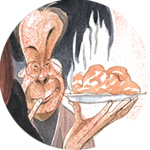 |
|
| Everybody's a critic
William Grimes, AM’74, PhD’82 On New Year’s Eve 2003, after five years as restaurant critic for the New York Times, William Grimes wrote his last review. He’ll stay on at the Times, but as a flurry of end-of-an-era media attention made plain, he has given up a foodie’s fantasy job. Education. After earning a bachelor’s (Indiana University) and a master’s in English, Grimes switched to the comparative study of literature, writing his dissertation on “The Critical Reception of Tolstoy in England, 1880–1910.” How the taste buds blossomed. “I was always a kid who would order the weirdest thing on the menu, the opposite of a picky eater,” Grimes said in a 2002 New York Public Library news release. “I was thrilled when my parents would take us to a restaurant, which was almost never, because it wasn’t something that happened that often in the 1950s.” While working at Esquire he was asked to write a cocktail column and segued into covering food history. Joining the New York Times Arts staff he also wrote about food for the Travel and Living sections before being named a food writer in 1997. After Ruth Reichel left the Times to become editor of Gourmet, Grimes took over the critic’s post. Critical flaw. When a Newsweek Web interviewer called being the Times restaurant reviewer “the coolest job on the planet,” Grimes responded that eating out day after day, night after night, isn’t all beer and skittles: “It’s like Groundhog Day. You wake up the next day having eaten a four-star meal, you must go out and eat another four-star meal. And you get up the next day and you have to go out and eat another four-star meal.” Guiding lights. Citing the paucity of adjectives to describe how foods taste, Grimes explained his writing strategy to Newsweek Web this way: “[W]hat you have to do is be fairly clever and figure out an end run around the problem. Usually metaphor is your savior.” He tried religiously to avoid the two stalwarts of restaurant reviews: “slathered” and “studded.” Reviewing the reviewer. “Built into the job,” Grimes told Newsweek Web, “is the idea that you don’t just cavalierly and maliciously go after a restaurant for the pleasure of it because you do have the power to ruin people’s careers and lives. Ultimately you’re writing for the reader, you’re not writing to make the restaurant owners happy. This is a truth that’s just not understood at all in the industry.” Short list. Straight Up or On the Rocks: The Story of the American Cocktail (North Point Press, 2001) and My Fine Feathered Friend (North Point Press, 2002), a short book prompted by the sudden appearance of a chicken, later named Chicken, in his backyard: “It was, in every way, a normal chicken, except for one thing. It was in the middle of New York City.” Grimes, who coauthored New York Times Guide to New York City Restaurants 2004 (New York Times, 2003), also curated the New York Public Library’s 2002 exhibition of metropolitan restaurant menus, New York Eats Out.
|
|
phone: 773/702-2163 | fax: 773/702-8836 | uchicago-magazine@uchicago.edu

